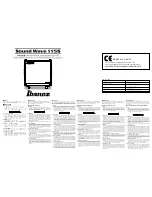
LX Series Digital
Chapter 3, Site Considerations,
Power Amplifier Assembly
Installation and Setup Procedures
Volume 2, Rev. 1
3-1
Chapter 3
Site Considerations, Installation and Setup Procedures
Table 3-1: LX Series Digital Transmitters AC Input and Current Requirements.
Transmitter
Voltage
Current
125 Watt
220 VAC
10 Amps to the Exciter/Amplifier Cabinet
250 Watt
220 VAC
15 Amps to the Exciter/Amplifier Cabinet
500 Watt
220 VAC
25 Amps to the Exciter/Amplifier Cabinet
1000 Watt
220 VAC
45 Amps to the Exciter/Amplifier Cabinet
1500 Watt
220 VAC
65 Amps to the Exciter/Amplifier Cabinet
220 VAC
45 Amps to the Exciter/Amplifier Cabinet
2000 Watt
220 VAC
40 Amps to the Amplifier Cabinet
220 VAC
45 Amps to the Exciter/Amplifier Cabinet
2500 Watt
220 VAC
60 Amps to the Amplifier Cabinet
220 VAC
65 Amp to the Exciter/Amplifier Cabinet
3000 Watt
220 VAC
60 Amps to the Amplifier Cabinet
3.1 Site Considerations
There are special considerations that
need to be taken into account before the
LX Series digital driver/transmitter can
be installed. For example, if the
installation is completed during cool
weather, a heat-related problem may not
surface for many months, suddenly
appearing during the heat of summer.
This section provides planning
information for the installation and set up
of the transmitter.
The AC input and current requirements
for LX Series digital transmitter/drivers
are shown in Table 3-1.
NOTES: The transmitter is factory set
for either 110 VAC or 220 VAC
operation as directed by customer.
Transmitters above 125 Watts use
220 VAC Input only.
Transmitters 2000 Watts and above
require two 220 VAC Inputs, one to
each cabinet.
The LX Series Digital Transmitters are
designed and built to provide long life
with a minimum of maintenance. The
environment in which they are placed is
important and certain precautions must
be taken. The three greatest dangers to
the transmitter are heat, dirt, and
moisture. Heat is usually the greatest
problem, followed by dirt, and then
moisture. Over-temperature can cause
heat-related problems such as thermal
runaway and component failure. Each
amplifier module in the transmitter
contains a thermal interlock protection
circuit that will shut down that module
until the temperature drops to an
acceptable level.
A suitable environment for the
transmitter can enhance the overall
performance and reliability of the
transmitter and maximize revenues by
minimizing downtime. A properly
designed facility will have an adequate
supply of cool, clean air, free of airborne
particulates of any kind, and no
excessive humidity. An ideal environment
will require temperature in the range of
40° F to 70° F throughout the year,
reasonably low humidity, and a dust-free
room. It should be noted that this is
rarely if ever attainable in the real world.
However, the closer the environment is
to this design, the greater the operating
capacity of the transmitter.
The fans are designed and built into the
transmitter will remove the heat from
within the modules, but additional means
are required for removing this heat from
the building. To achieve this, a few issues
need to be resolved. The first step is to
















































